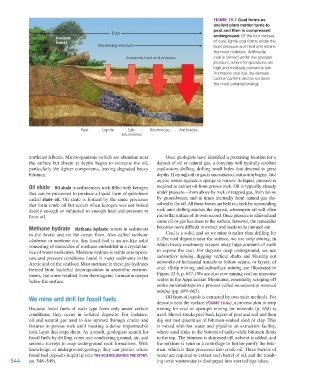Page 545 - Environment: The Science Behind the Stories
P. 545
FIGURE 19.7 Coal forms as
ancient plant matter turns to
peat and then is compressed
Time
Ancient underground. Of the four classes
forest of coal, lignite coal forms under the
Decreasing moisture least pressure and heat and retains
the most moisture. Anthracite
Increasing heat and pressure coal is formed under the greatest
pressure, where temperatures are
high and moisture content is low.
Anthracite coal has the densest
carbon content and so contains
the most potential energy.
Peat Lignite Sub- Bituminous Anthracite
bituminous
northeast Alberta. Microorganisms (which are abundant near Once geologists have identified a promising location for a
the surface but absent at depth) began to consume the oil, deposit of oil or natural gas, a company will typically conduct
particularly the lighter components, leaving degraded heavy exploratory drilling, drilling small holes that descend to great
bitumen. depths. If enough oil or gas is encountered, extraction begins. Just
as you would squeeze a sponge to remove its liquid, pressure is
Oil shale Oil shale is sedimentary rock filled with kerogen required to extract oil from porous rock. Oil is typically already
that can be processed to produce a liquid form of petroleum under pressure—from above by rock or trapped gas, from below
called shale oil. Oil shale is formed by the same processes by groundwater, and at times internally from natural gas dis-
that form crude oil but occurs when kerogen was not buried solved in the oil. All these forces are held in check by surrounding
deeply enough or subjected to enough heat and pressure to rock until drilling reaches the deposit, whereupon oil will often
form oil. rise to the surface of its own accord. Once pressure is relieved and
some oil or gas has risen to the surface, however, the remainder
Methane hydrate Methane hydrate occurs in sediments becomes more difficult to extract and needs to be pumped out.
in the Arctic and on the ocean floor. Also called methane Coal is a solid, and so we mine it rather than drilling for
clathrate or methane ice, this fossil fuel is an ice-like solid it. For coal deposits near the surface, we use strip mining, in
consisting of molecules of methane embedded in a crystal lat- which heavy machinery scrapes away huge amounts of earth
tice of water molecules. Methane hydrate is stable at tempera- to expose the coal. For deposits deep underground, we use
ture and pressure conditions found in many sediments in the subsurface mining, digging vertical shafts and blasting out
Arctic and on the seafloor. Most methane in these gas hydrates networks of horizontal tunnels to follow seams, or layers, of
formed from bacterial decomposition in anaerobic environ- coal. (Strip mining and subsurface mining are illustrated in
ments, but some resulted from thermogenic formation deeper Figure 23.6, p. 657.) We are also now mining coal on immense
below the surface. scales in the Appalachian Mountains, essentially scraping off
entire mountaintops in a process called mountaintop removal
mining (pp. 659–663).
We mine and drill for fossil fuels Oil from oil sands is extracted by two main methods. For
deposits near the surface (FIGURE 19.8a), a process akin to strip
Because fossil fuels of each type form only under certain mining for coal or open-pit mining for minerals (p. 658) is
conditions, they occur in isolated deposits. For instance, used. Shovel-trucks peel back layers of peat and soil and then
oil and natural gas tend to rise upward through cracks and dig out vast quantities of bitumen-soaked sand or clay. This
fissures in porous rock until meeting a dense impermeable is mixed with hot water and piped to an extraction facility,
rock layer that traps them. As a result, geologists search for where sand sinks to the bottom of tanks while bitumen floats
fossil fuels by drilling cores and conducting ground, air, and to the top. The bitumen is skimmed off, solvent is added, and
seismic surveys to map underground rock formations. With the mixture is spun in a centrifuge to further purify the bitu-
knowledge of underground geology, they can predict where men, which is then processed into crude oil. Three barrels of
fossil fuel deposits might lie (see THE SCIENCE BEHIND THE STORY, water are required to extract each barrel of oil, and the result-
544 pp. 548–549). ing toxic wastewater is discharged into vast tailings lakes.
M19_WITH7428_05_SE_C19.indd 544 12/12/14 5:22 PM

